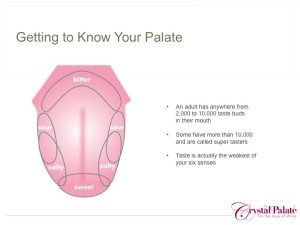Getting to know your palate can be a big key to understanding your love of wine. Do you ever wonder why you select the same wine time and time again? Do you love sweet Moscato and can’t bear the thought of ingesting a heavy dry red or do you love a big bold Cabernet Sauvignon and simply refuse to sip on a Riesling?
There are many things that contribute to your personal palate preferences. Understanding a few things about your palate will make that next wine choice a little less daunting and it may even expand your love of wine. With more than 5,000 varietals to explore, life’s too short to drink the same wine all the time.
Getting to Know Your Palate?
First of all, keep in mind there is no universal palate. The average person has 10,000 taste buds. Our sense of taste is actually our weakest sense. Much of the enjoyment we experience with a glass of wine is actually derived from our sense of smell. Researchers estimate that 80-85% of our sense of taste comes directly from our sense of smell.
 This chart shows where our specific taste buds are located. We taste sweet with the tip of our tongue. Many people confuse sweet with fruity. Don’t be fooled. Think of a Chardonnay from Australia or Chile for example. You will most likely experience a lot of fruit like apples, lemon and pineapple, but this wine will have a dry finish.
This chart shows where our specific taste buds are located. We taste sweet with the tip of our tongue. Many people confuse sweet with fruity. Don’t be fooled. Think of a Chardonnay from Australia or Chile for example. You will most likely experience a lot of fruit like apples, lemon and pineapple, but this wine will have a dry finish.
To determine what style of wine you might like, think about your preference when it comes to tea and coffee. Do you drink oolong tea or espresso straight up? If so, you probably enjoy the tactical sensation of tannins that tend to be more pronounced in red wines. Reach for a red like Merlot, Cabernet Sauvignon, Barolo and Brunello.
If you like your tea or coffee with a little cream, you probably like your tannins more on the smoother side with a silkier feel, so reach for a Pinot Noir, Pinot Meunier or Grenache.
If you reach for the sugar and cream, you just might like a Riesling, Moscato, Vouvray, Sauternes or Port.
So what are tannins?
Think triple”T”. Tannins, tongue & teeth.
Tannins come from the grape’s skin, seeds and stems and can also come from oak aging. You feel tannins on your tongue and teeth. It can sometimes feels like sandpaper or it can have more of a silky texture. In the wine world, you will hear everything from chewy tannins, grippy tannins, rugged tannins to smooth tannins.
Think about a cup of tea. If you leave a tea bag in too long, you wind up with bitter tannins. The only way to counteract that sensation is to add milk or cream. Lemon will only make it the tea seem more bitter and sugar will leave you with a bitter sweet taste in your mouth. This is why you often see cheese paired with tannic wines. It cuts down on the rugged texture and smooths out the tannins. You can try this exercise at home. Purchase a youthful Cabernet Sauvignon 2010 or 2011 in the $15-$20 range and drink a sip and let it linger on your palate. Think about how that sensation feels. Then take a piece of cheese (aged cheddar, gouda or blue cheese) and try the wine again. You will notice a big difference on your tongue.
Check out Master of Wine Jennifer Simonetti-Bryan’s The One Minute Wine Master, for a fun read to learn more about your palate preferences in 60 seconds or less.
Understanding why we taste what we taste is a great way start to appreciating different types of wines. Always let your palate be your guide, but don’t be afraid to drink “outside the box”!

